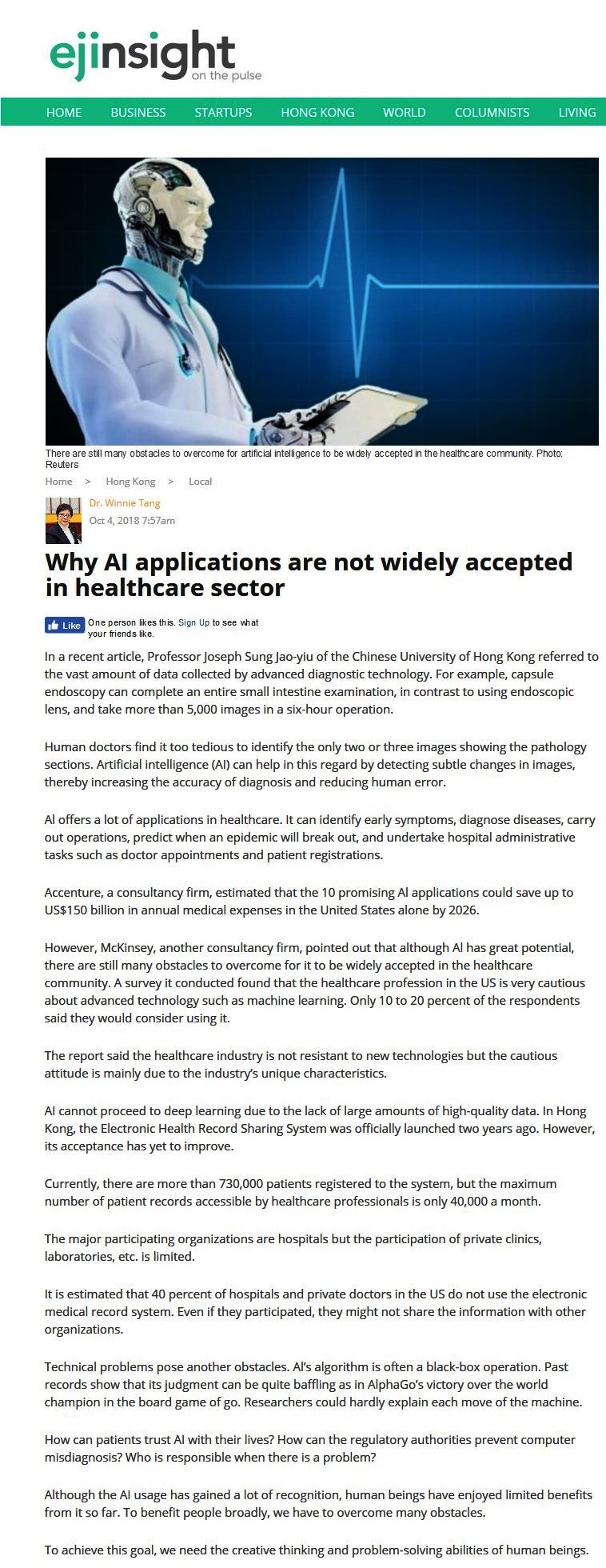上版請按此

Why AI applications are not widely accepted in healthcare sector
In a recent article, Professor Joseph Sung Jao-yiu of the Chinese University of Hong Kong referred to the vast amount of data collected by advanced diagnostic technology. For example, capsule endoscopy can complete an entire small intestine examination, in contrast to using endoscopic lens, and take more than 5,000 images in a six-hour operation.
Human doctors find it too tedious to identify the only two or three images showing the pathology sections. Artificial intelligence (AI) can help in this regard by detecting subtle changes in images, thereby increasing the accuracy of diagnosis and reducing human error.
Al offers a lot of applications in healthcare. It can identify early symptoms, diagnose diseases, carry out operations, predict when an epidemic will break out, and undertake hospital administrative tasks such as doctor appointments and patient registrations.
Accenture, a consultancy firm, estimated that the 10 promising Al applications could save up to US$150 billion in annual medical expenses in the United States alone by 2026.
However, McKinsey, another consultancy firm, pointed out that although Al has great potential, there are still many obstacles to overcome for it to be widely accepted in the healthcare community. A survey it conducted found that the healthcare profession in the US is very cautious about advanced technology such as machine learning. Only 10 to 20 percent of the respondents said they would consider using it.
The report said the healthcare industry is not resistant to new technologies but the cautious attitude is mainly due to the industry's unique characteristics.
AI cannot proceed to deep learning due to the lack of large amounts of high-quality data. In Hong Kong, the Electronic Health Record Sharing System was officially launched two years ago. However, its acceptance has yet to improve.
Currently, there are more than 730,000 patients registered to the system, but the maximum number of patient records accessible by healthcare professionals is only 40,000 a month.
The major participating organizations are hospitals but the participation of private clinics, laboratories, etc. is limited.
It is estimated that 40 percent of hospitals and private doctors in the US do not use the electronic medical record system. Even if they participated, they might not share the information with other organizations.
Technical problems pose another obstacles. Al's algorithm is often a black-box operation. Past records show that its judgment can be quite baffling as in AlphaGo's victory over the world champion in the board game of go. Researchers could hardly explain each move of the machine.
How can patients trust AI with their lives? How can the regulatory authorities prevent computer misdiagnosis? Who is responsible when there is a problem?
Although the AI usage has gained a lot of recognition, human beings have enjoyed limited benefits from it so far. To benefit people broadly, we have to overcome many obstacles.
To achieve this goal, we need the creative thinking and problem-solving abilities of human beings.
Dr. Winnie Tang
Honorary Professor, Department of Computer Science, The University of Hong Kong